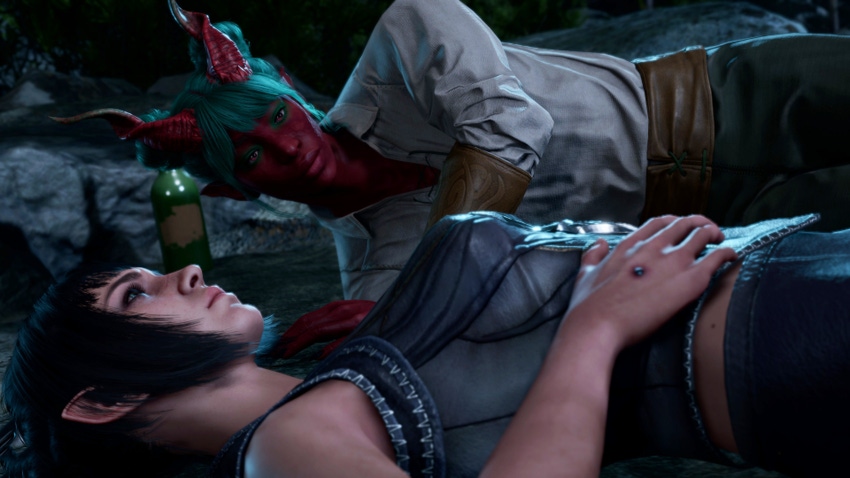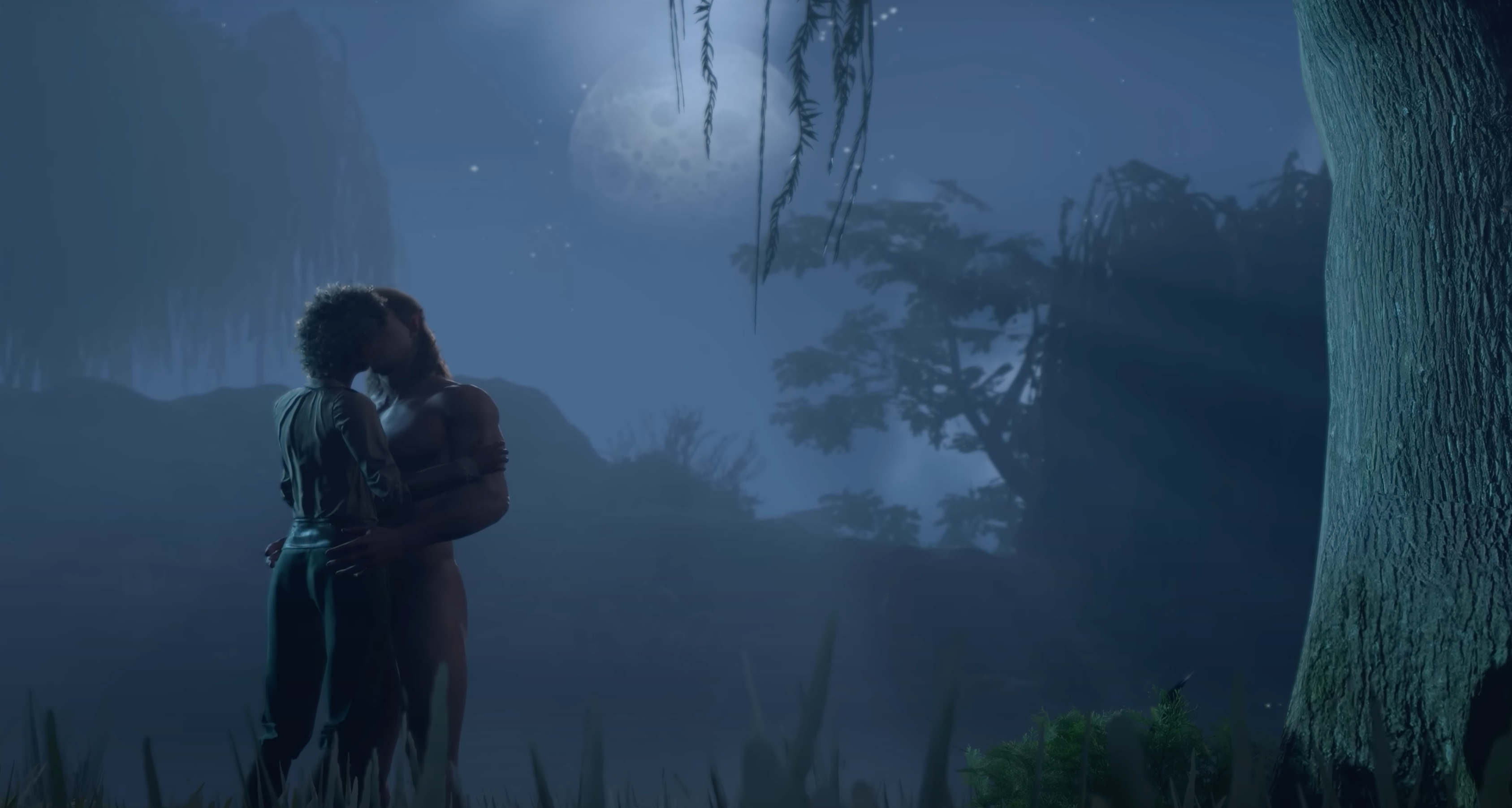Baldur's Gate 3's romances aren't the same old love song
Far from being a "playersexual" throwback, BG3 points to a rich future for an old idea.

Spoilers for Baldur's Gate 3
"I've played porn games that were less horny than this," was my fiancée's verdict on Baldur's Gate 3—and she meant this as a compliment. There are delectations that Baldur's Gate 3 cannot touch, of course (one has to look to titles like Ladykiller in a Bind for a particularly unsparing eroticism that finds both the joy and humor in kinky sex), but BG3 comes shockingly close for a AAA title pitched at a mass audience.
It deserves its share of praise for depicting sexuality in ways that wax and wane from the amusingly sophomoric to the genuinely erotic to the delicate and tender. But more than even that, we now have a CRPG in the BioWare model that enables proper polyamory—without hacks, extremely esoteric or buggy play strategies, or mods.
The fact that your custom character can get into a polycule with Shadowheart and Halsin is more than a little notable, after all. But beyond that, there's a critique that's started to emerge about this game's portrayal of its "romance options," and it's an argument that I thought had been dead and buried since around 2012: that characters have no defined sexuality, as such, but playersexuality.
That they have no identity save whatever is most congenial for the fantasy of the player, and thus diminishing of any agency or independent identity of the non-player characters.
Of course, a one-off threesome does not polyamory make. But it hinted at other possibilities, if nothing else, and was a clear indication of the player not always being at the center of her desires. With other characters it was admittedly less clear.
But there's also something to be said for a world where queerness was so normalized that it usually didn't require special mention—a fact made clear in Dragon Age: Inquisition, in a book the player can find in their travels by the peerless in-universe chronicler of all things anthropologically Thedan, Brother Genitivi:
"Typically, one's sexual habits are considered natural and separate from matters of procreation, and only among the nobility, where procreation involves issues of inheritance and the union of powerful families, is it considered of vital importance. Yet, even there, a noble who has done their duty to the family might be allowed to pursue their own sexual interests without raising eyebrows."
As I understand from former BioWare employees speaking on background, this codex entry was written to provide something of a definitive statement on how homosexuality is viewed across Thedas.
In short: it's as diverse as one might expect, though modally less homophobic than the real world. Genitivi goes on to write, "the view on indulging lusts with a member of the same gender varies from land to land," and the game makes this clear over the course of its three entries—providing ample sociological basis for the homophobia experienced by the Tevinter mage Dorian, but also the relative nonchalance about queerness expressed by or through other characters.
The allegation of playersexuality in DA2 was dramatically overstated. There's nothing wrong with providing queer players with a fantasy of a world where we don't need to explain or justify ourselves. There's obvious appeal to a universe where who we are is so normal and uncontroversial that it barely needs to be remarked upon in any direct way.
Queer sexuality and NPCs
This brings us from Thedas to Faerûn. If the "playersexuality" argument was overstated in the case of DA2, the fertile soil whence it was born, then how does it hold up with BG3? Even more poorly. The game's novel portrayal of polyamory (for a AAA game, at least) demonstrates why.
Playersexuality requires an NPC to:
(1) Forego any personal or cultural explanation for their sexuality,
(2) Demonstrate unequivocally that their sexuality towards the player character is unique, discrete, and exists for the sole purpose of pleasing the player; they must not evidence any other sexual activity that hints at queerness, polyamory, or kinkiness.
(3) Be incapable of rejecting the player.
There's far more I could say about (3) as it keys into the vending machine model of romance options; provide the NPC with sufficient gifts and out pops a sex scene! But we can interpret it loosely for our purposes and say that playersexuality requires that there be no credible game states where an otherwise romanceable character can reject a player character.
Baldur's Gate 3, measured by these three criteria, is quite far from a playersexual game. And it is, at last, time for us to examine our favorite Goth/Bear polycule to make the case.
If you choose to play as an original character, you can play someone who falls in love with the wayward Sharran Cleric Shadowheart and form a meaningful relationship with the noble Druid and all around beefy Elf Halsin. Together, the three of you can engage in other sexual explorations throughout the city of Baldur's Gate, with many amusing and sweet reflections along the way.
Much is made of the fact that Shadowheart does not know how to swim; a pivotal romance scene has your character potentially helping her to learn. Upon hearing of this, Halsin, in a very polite and noble manner, offers to shapeshift into a porpoise to aid Shadowheart's lessons—while also suggesting it can be a date. It's profoundly sweet and very poly, even if this only occurs in party banter while you're exploring.
But most important of all, both characters attribute their differing flavors of polyamory to different personal preferences and cultural contexts—Shadowheart to the sociality of a Sharran cloister ("there's stories I could tell you…"), and Halsin to his views on nature being free of hierarchy. If brought into particular situations (i.e. an orgy with two Drow, yourself, and perhaps someone else), Halsin talks at length about his previous sexual experiences—not all of them pleasant, but all of them assuredly his, and not centered on the player.
"Let others know the happiness of being with you," he says, if you ask him about his views on you having other lovers. They're words that could just as easily have been spoken by any of my own partners, and they clearly express a view on sexuality that is independent of your character's intervention.

Player sexuality requires that the player be implied to be the only non-normative sexual experience that the character has had (their first gay or kinky or poly experience), but for this fact to never be remarked upon at all, nor lead to any character development, nor be repeated with anyone who isn't the player character. At its strongest, the invocation of the playersexuality critique is a call for stronger writing—and who could argue with that?
But applying it to every game where most or all of the romance options are bi/pansexual feels inadvertently prejudicial in its own right. Especially when the criteria for the strong-version of the argument aren't met. BG3 is horny for many reasons, not just the mere presentation of sex, but the frequent discussion of it (and recent bug-fixes don't change that).
More importantly, everyone expresses a sexual character. The philosopher Martha Nussbaum, applying rigorous thought to the oft-misused idea of "objectification," argued that it has several key characteristics—among the most important of these is "fungibility," the idea that a truly objectified person is shorn of all distinguishing features and humanity, and thus their body is fungible with anyone else's.
That's not the case here. Shadowheart and Halsin each have rather distinctive sexual footprints (for one thing, Halsin's is suspiciously bear-shaped). Shadowheart's sensuality is slow, gentle, and cautious—while also allowing her primary partner to find pleasure elsewhere as long as she's kept in the loop. Halsin is ferocious, forceful, moves quickly, and yet is an equally tender communicator.
Lae'zel? Her job is ‘top.' Karlach wants to go on a date and is a cuddly cinnamon bun. On and on and on. These people are characters, and this includes and pervades their sexuality.
Potentials and stumbles
That doesn't mean there isn't room for improvement, of course, and this is where I think a productive discussion can be had. It appears that romance options are still gated behind character approval, regardless of how you're playing more broadly.
Does it make sense for Lae'zel to fall head over heels for you if you're being squishy and conciliatory? Might it make even more sense if there were more conversations that illustrate a change in her thinking? Is her larger plot with Vlaakith meant to be a proxy for this?
A possible unspoken reason for everyone being pansexual by default might be the fact that the game permits you to be trans and nonbinary—from physiology to identity. But the fact that it's unspoken is a missed opportunity, the subject of (so far as I can tell) precisely zero meaningful conversations with your lovers.
But even these shortcomings and lingering questions show that this model of CRPG "romance option" is far from dead; it's filled with vigorous life and potential still.
That means that there's room to build. Shadowheart and Halsin show one possible iteration of this: what it looks like to portray polyamory as an affirmative choice of the characters, woven into their backstory, thus allowing them to express their agency rather than act merely as a convenience for the player.
This framework can go further still, with dynamic interactions that allow for the co-development of a player character and a romanceable NPC who can, in the manner of real couples, change and grow together. BG3 provides real, tantalizing hints of this. Shadowheart learns who she is and learns more about her past, which changes the texture of your relationship with her, for example. Astarion can… make you worse.
It's far from perfect. And, in the end, if you stare through the illusion you can see the numbers behind it, see some unfortunate hints of the old vending machine model. But the garnish and the layers of illusion magic around it do matter. The degree to which BG3's companions have inspired fanfic, fanart, memes, and all around adoration is a testament to the strength of their writing. Which, thankfully, infuses their sexual sides as well.
But I wouldn't simply dismiss the game as "playersexual." Instead, it provides an inspiring framework to build on.
Read more about:
FeaturesAbout the Author(s)
You May Also Like













